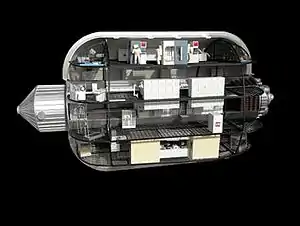BA 2100
The BA 2100, or Olympus,[3] is a conceptual inflatable space habitat[2] by Bigelow Aerospace. The larger BA 2100 would extend the volume and capabilities of the B330 module, which is under development as part of the Bigelow Commercial Space Station.[4] As with the B330 module, the number in the name refers to the number of cubic meters of space offered by the module when fully expanded in space (equivalent to 74,000 cubic feet).[5]
 Model of the BA 2100 space station | |
| Station statistics | |
|---|---|
| Crew | 16 [1] |
| Mission status | Proposed |
| Mass | 65,000–70,000 kg (143,000–154,000 lb) [1][2] |
| Length | 17.8 m (58 ft) |
| Diameter | 12.6 m (41 ft) |
| Pressurised volume | 2,250 m3 (79,000 cu ft) [3] |
The mass of the BA 2100 could be as low as 65,000 to 70,000 kg (143,000 to 154,000 lb),[1][2] but would more likely be "in the range of 100 metric tons".[6] It is substantially larger than the B330, with the docking ends of the module alone estimated at approximately 7.6 m (25 ft) in diameter.[2] The concept model showed the docking ports at both ends.[5] The BA 2100 would require the use of a super heavy-lift launch vehicle and would require an 8 m (26 ft) fairing for launch. Suitable vehicles include the Block 2 version of the Space Launch System, designed for a 130,000 kg (290,000 lb) payload capacity to low Earth orbit (LEO),[6] or the satellite delivery version of the SpaceX Starship, planned to carry 150,000 kg (330,000 lb) to LEO.[7]
Pressurized volume of single BA 2100 module is 2,250 m3 (79,000 cu ft),[3] compared to 931 m3 (32,900 cu ft) volume of the whole International Space Station as of May 2016.
See also
References
- Bigelow Aerospace (24 May 2011). "International Space Development Conference - Bigelow Slideshow" (PDF). Spaceref.com. Retrieved 27 May 2011.
- Simberg, Rand (28 October 2010). "Bigelow Aerospace Shows Off Bigger, Badder Space Real Estate". Popular Mechanics. Retrieved 11 December 2010.
- Higginbotham, Adam (2 May 2013). "Robert Bigelow Plans a Real Estate Empire in Space". Business Week. Archived from the original on 4 May 2013.
- "Bigelow Marketing Inflatable Space Stations". Aviation Week. 6 May 2010. Retrieved 11 December 2010.
- Wang, Brian (29 October 2010). "BA-2100 module and other Bigelow Aerospace news". nextbigfuture.com. Archived from the original on 3 November 2010. Retrieved 2 November 2010.
- Messier, Douglas; Ingham, Jay (21 October 2010). "Bigelow Aerospace's Space Station". youtube.com. International Symposium for Private and Commercial Spaceflight. Event occurs at 2:45. Retrieved 11 December 2010.
... if a super-heavy-lift launch vehicle ever did exist ... would require an 8-meter fairing to launch this ... BA-2100 ... probably in the range of around 100 metric tons. ... We have concepts of slightly smaller modules that would fit on the modified Delta IV ... 70 metric tons, six- or seven-meter fairing ... about 1150 cubic meters ... equivalent to the existing space station.
- Wang, Brian (30 September 2017). "Each Spacex Big Rocket could launch 4200 Cubic Meters of Bigelow Space Station for a new Space age". Next Big Future. Retrieved 8 April 2018.